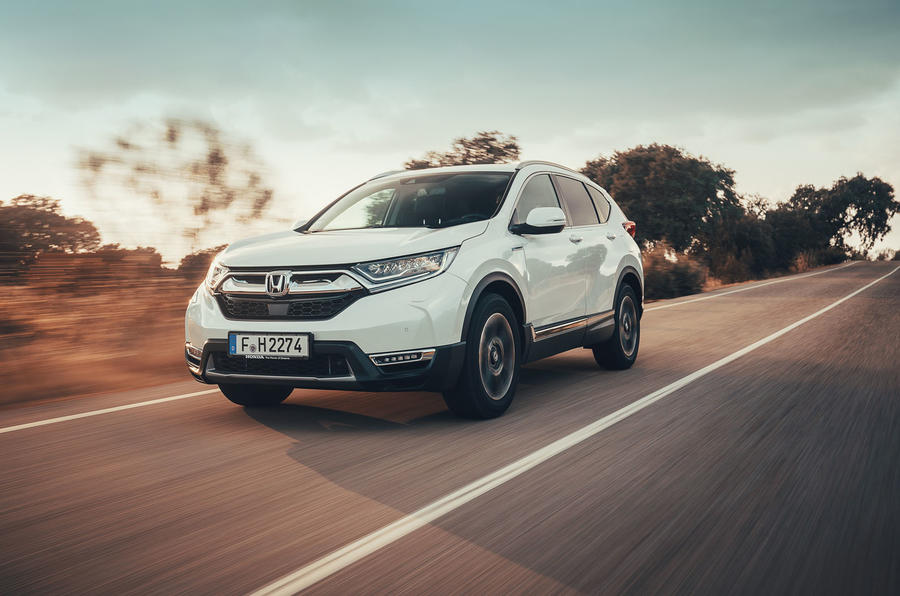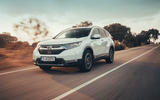What is it?
It was already the first Honda SUV to offer seven seats, but now the fifth-generation CR-V has scored a second debut: it becomes the first SUV from the brand to be sold in Europe with a hybrid motor.
Honda is even going so far as to call the intelligent multi-mode drive (I-MMD) powertrain the most important one it has launched in the past decade. As it filters through to the rest of the range, it will play a big part in helping the company hit its goal of two-thirds of all sales across Europe being alternative fuelled vehicles by 2025.
Now that diesel engines are entirely absent from the CR-V line-up, it also becomes the de facto option for customers who prioritise fuel economy. So no pressure, then.
The hybrid system uses two electric motors in addition to a 2.0-litre i-VTEC petrol engine: one for propulsion, producing 181bhp and 232lb ft of torque, and another for generating electricity that gets stored in a lithium ion battery. All are connected through a direct transmission with single fixed gear ratio, which Honda says allows for smoother torque delivery.
The car dynamically switches between EV, hybrid and engine drive modes, with the former drawing power solely from the battery. In hybrid drive mode, the engine supplies power to the generator, which in turn supplies it to the propulsion motor. Only in engine drive mode is the petrol motor connected directly to the wheels via a lock-up clutch.
The car switches between all three dynamically to maximise battery power, and to keep the engine in its optimal power band for as long as possible. Any excess shove it creates in hybrid mode is diverted to recharge the battery, and the battery can assist in engine mode for a boost to performance. It equates to a 0-60mph time of 8.8sec in front-wheel-drive guise, and 9.2sec for the all-wheel-drive model. Top speed is the same, at 112mph.
Honda expects the lion’s share of sales to be for the all-wheel-drive version, and it’s the one we’ve tested here. An equal split is also predicted between petrol and hybrid models, although with only £800 separating them, Honda is doing everything it can to make the hybrid more appealing to customers.

















































Join the debate
Add your comment
Give and Take
Sounds a bargin at first Top-spec, quickish, 4wd, SUV, Auto, Hybrid, 7 seater Honda then you realise they've had to take 2 seats out put in a tiny battery. Another thing that makes it sound like a bargin at first is the tiny £800 step down to the ICE version but then that has 7 seats so the price difference is more like £2000 going by normal mark ups.
All of a sudden Hybrids are so cheap
xxxx wrote:
It is pricey, £35K for 4wd SR which seems to be the sweetspot to me (although spec levels are pretty high from base model up). If you forget 7 seats and compare to its real competition larger 5 seat diesel SUV's it does OK
A Tiguan 5 seat diesel 190bhp 4wd auto SEL spec model with options to match a CR-V SR is £37K
missed the n't
...Should have been aren't so cheap.
@The Appentice
Thanks for the explanations, both interesting and helpful. I wonder how efficient this is on a long motorway cruise; though if the electric motor provides a bit of extra shove uphill maybe it'll work fine. A group text with other hybrid SUVs would be good along with a long term test. I also wonder how scalable this system is and whether it will fit in the Civic and HRV without too much compromise.
Will86 wrote:
Actually I think a group test with other diesel SUV's would be good, as Honda have dropped diesels from the CR-V completely. If this system can in the real world compete for economy a diesel X-trail, Q5, Sportage, Tiguan, etc then it really is a diesel killer, petrol around my way is up to 10p a gallon cheaper so even if it comes close its a winner.
Would be much better if they
Would be much better if they used the 1.6 diesel instead of the 2 litre petrol - more efficient, lower mpg, lower CO2, better at charging batteries.
typos1 wrote:
you would think so,
But diesels are more difficult due to the limited rev range, you would either have to only clutch it in at a higher speed (meaning more double energy conversion running time) or limit top speed a lot more - or fit a gearbox which would be a huge complication and weight gain.
Plus with the hybrid gear as well as an engine your running short on space for all the bits and pieces with the diesel filters, as it is the CRV hybrid loses some boot space to get it all in. The bonus here is the CR-V hybrid is barely compromised at all, 80 litres less boot but its still big.
Also the diesel is quite a bit heavier, with the hybrid bits would make the car too heavy to be as efficient as it is.